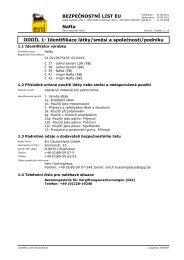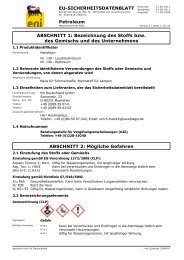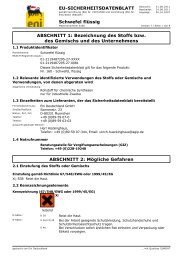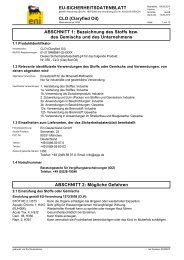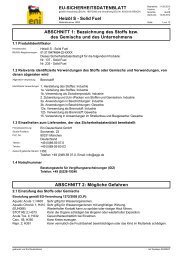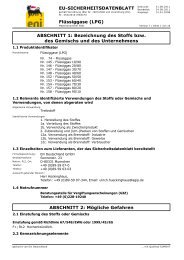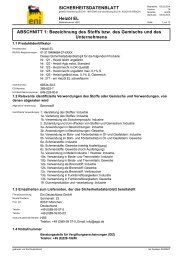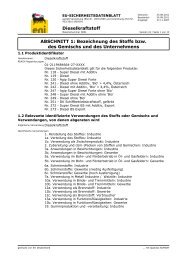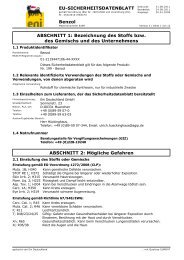EU-SICHERHEITSDATENBLATT Dieselkraftstoff ... - Schmierstoffe
EU-SICHERHEITSDATENBLATT Dieselkraftstoff ... - Schmierstoffe
EU-SICHERHEITSDATENBLATT Dieselkraftstoff ... - Schmierstoffe
You also want an ePaper? Increase the reach of your titles
YUMPU automatically turns print PDFs into web optimized ePapers that Google loves.
Vacuum Gas Oils, Hydrocracked Gas Oils, and Distillate Fuels<br />
Appendix 2.b. Qualitative Exposure Estimation<br />
Qualitative Exposure Estimation for R20 substances<br />
There is a difference of at least a factor of 30 between the short-term (when expressed over 15<br />
minutes) and the long term DNELs (when expressed over 8 hours)), i.e. the long-term DNEL is lower<br />
by at least 30x. In these circumstances a quantitative assessment of short-term exposure assessment<br />
has not be undertaken based on the following rationale:<br />
- For any single short term (ST) event to adversely influence the implementation of the long term<br />
(LT) reference value (DNEL when available) in the CSA, then the single ST exposure must be<br />
~30x greater than the LT DNEL. Where the ST exposure might be repeated during the course of<br />
an activity, then the contribution made by the ST exposures to the LT average would clearly be<br />
greater. Hence, provided daily average exposures are controlled to within the LT reference value,<br />
then this will also account for any potential risks arising from ST exposure.<br />
Qualitative Exposure Estimation for R38 substances<br />
This general qualitative CSA approach aims to reduce/avoid contact or incidents with the substance.<br />
However, implementation of risk management measures (RMMs) and operational conditions (OCs)<br />
need to be proportional to the degree of concern for the health hazard presented by the substance.<br />
Exposures should be controlled to at least the levels that represent an acceptable level of risk, i.e.<br />
implementation of the chosen RMMs will ensure that the likelihood of an event occurring due to the<br />
hazard of the substance is negligible, and the risk is considered to be controlled to a level of no<br />
concern.<br />
For skin irritation a qualitative risk characterisation was conducted. Handling and storage risk<br />
management measures that are generally identified for skin irritation and identified in the Table given<br />
in Appendix 3.b.<br />
A review of these RMMs indicates that if the user complies with the following generic statements, risks<br />
due to skin irritation can be considered to be adequately controlled:<br />
E3: Avoid direct skin contact with product. Identify potential areas for indirect skin contact.<br />
Wear gloves (tested to EN374) if direct hand contact with substance likely. Clean up<br />
contamination/spills as soon as they occur. Wash off skin contamination immediately. Provide<br />
basic employee training to prevent / minimise exposures and to report any skin effects that<br />
may develop.<br />
Plus (where there is the potential for additional and significant aerosol exposure, e.g. associated with<br />
PROCs 7, 11, 17 or 18):<br />
E4: Other skin protection measures such as impervious suits and face shields may be<br />
required during high dispersion activities which are likely to lead to substantial aerosol<br />
release, e.g. spraying.<br />
Qualitative Exposure Estimation for R65 substances<br />
‘Aspiration’ means the entry of a liquid substance directly into the trachea and lower respiratory tract.<br />
Aspiration of hydrocarbon substances can result in severe acute effects such as chemical<br />
pneumonitis, varying degrees of pulmonary injury or death. This property relates to the potential for<br />
low viscosity material to spread quickly into the deep lung and cause severe pulmonary tissue<br />
damage. Classification of a hydrocarbon substance for aspiration hazard is made on the basis of<br />
reliable human evidence or on the basis of physical properties.<br />
The R65 risk phrase (Harmful: may cause lung damage if swallowed) relates to potential for<br />
aspiration, a non-quantifiable hazard determined by physico-chemical properties (i.e. viscosity) that<br />
can occur during ingestion and also if it is vomited following ingestion. A DNEL cannot be derived.<br />
This general qualitative CSA approach aims to reduce/avoid contact or incidents with the substance.<br />
However, implementation of risk management measures (RMMs) and operational conditions (OCs)<br />
need to be proportional to the degree of concern for the health hazard presented by the substance.<br />
Exposures should be controlled to at least the levels that represent an acceptable level of risk such<br />
that the implementation of the chosen RMMs will ensure that the likelihood of an event occurring due<br />
to the substance hazard is negligible, and the risk is considered to be controlled to a level of no<br />
concern.<br />
There are no routine anticipated exposures by ingestion related to any supported uses of the<br />
2010-07-30 CSR Appendix 2




